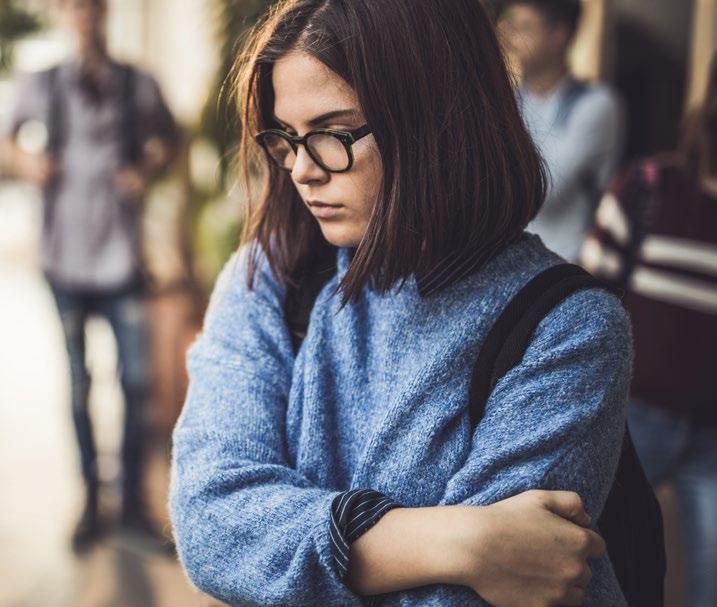
8 minute read
THE ANXIETY GAP
Why younger women and girls are experiencing higher rates of anxiety
By Julia Zuckernick and Sue-Ann Maislin
Advertisement
Julia Zuckernick, 25, is a post-graduate student planning to pursue a master’s degree in counselling psychology. She has a bachelor’s degree in Sociology from Wilfrid Laurier University and a certificate in Mediation from Durham College.
Sue-Ann Maislin, 56, has a master’s degree in Counselling Psychology and Adult Education from the University of Toronto and a post-graduate certificate in Workplace Wellness and Health Promotion from Centennial College.
Let’s face it, we all experience temporary anxiety, which can include worry, restlessness, difficulty concentrating and sleep disruption in response to life’s ups and downs. Not only is anxiety normal, it can help us solve problems, build better relationships and rise in a challenge. But for some, anxiety can become more persistent and severe and interfere with our mood, relationships, life and work.
While anxiety affects all genders, younger women and girls seem to have it worse. From the time they hit puberty, women and girls are two times more likely to struggle with anxiety, affecting them from childhood to midlife. Dr. Lisa Damour, a psychologist and author of Under Pressure: Confronting the the age of 6, girls experience anxiety disorders more frequently than boys, with the trend continuing into adolescence and beyond.”
A 2018 study from the American Psychological Association found that teens report feeling more anxious in their day-to-day life than their parents and grandparents. Teens experience muscle tension, restlessness, worrying thoughts, appetite change, Epidemic of Stress and Anxiety in Girls, writes, “From sleep disturbances, and chronic fatigue, which were once the domain of their full-time working parents. Youths have traditionally been at risk of experiencing mental health problems. Yet girls and young women are still more likely to live with persistent anxiety than boys are, and we wanted to understand why.
Based on our research and anecdotal experiences, we’ve discovered three themes:

1. NATURE OR NURTURE
Being female is considered the strongest predictor for experiencing an anxiety disorder, but how much does biology versus the environment play a role? Research is not conclusive when it comes to gender differences and biology, but there is evidence that hormonal differences, alongside the onset of puberty, are key factors.
Girls typically reach puberty at least two years ahead of boys. Since the late 20th century, the mean age of girls entering puberty is declining, while for boys things have stayed the same. In recent years, it’s not uncommon to see girls as young as 6 or 7 develop glandular breast tissue and begin menstruation by age 9.
When it comes to experiencing anxiety, the age of puberty makes a difference. Increasing hormones, sudden growth spurts and the development of mature body characteristics often constitute a stressful and confusing time for girls, but younger girls report feeling unprepared and awkward. As their bodies develop, their peers, parents, and teachers begin to treat them differently; the unwanted attention adds to the anxiety. This is further compounded by influencers and images on social media, encouraging young girls to look and act more mature in their posts.
Our review uncovered only sporadic evidence that biology plays a role in anxiety. There is a stronger and more compelling argument that social and psychological factors -- like conforming to impossible standards of beauty, sexuality and femininity, along with conflicting societal messages about gender roles -- play an even greater part. Girls and women experience internal pressures toward perfectionism from a young age, wanting to look their best, outperform boys and men at school and work, and be the perfect partner, daughter and mother.
In our increasingly digital world, women and girls are inundated with images and influencers on social media, sending the message that they are mainly valued for how they look. Generation Zs (people born after 1996) are feeling more pressure to
conform and perform than women and girls in earlier generations, facing surveillance and scrutiny like never before.
2. THE TIKTOK REVOLUTION
According to a study published in 2017 in the American Journal of Epidemiology, higher social media use is correlated with self-reported declines in mental and physical health and life satisfaction. Social media apps like TikTok and Instagram help people feel connected, but they can also fuel unhealthy comparison and doubts about self-worth. As social media use increased in the mid to late 2000s, we saw an increase in mental health issues among youth.
Generation Zs are the first generation in history to be exposed to social media in elementary school. Social media design is linked to addictive behaviours in “users” who are constantly posting, scrolling, and reacting to get their fix. Evidence shows that receiving likes and notifications on social media is linked to increased dopamine activity in the brain. Dopamine, a neurotransmitter, influences how we feel pleasure.
Younger millennials were the experimental generation learning to use social media apps like Facebook in their formative years. While these platforms increased their ability to interact and have fun, they also may have fuelled feelings of isolation and inadequacy, along with a phenomenon called FOMO – fear of missing out. “It’s easy to get sucked into other people’s timelines and life accomplishments” in the belief that their lives are always better than your own, as Julia notes.
“We are raising the first generation that spends hours each day fretfully curating and posting selfies and videos in the hopes they will receive an avalanche of likes,” Damour writes, “and it’s girls who suffer more.”

3. NOT GOOD ENOUGH
The need to feel connected to and accepted by peers is not new for women and girls. Most Gen-X and Boomer women can remember being glued to their landline for hours talking to friends, or spending an hour in front of the mirror each morning to make sure their hair and makeup looked perfect before venturing to school or the mall. Levels of pressure are much more intense today for Gen Z women and girls, however. To gain approval and acceptance from friends, teenage girls post two to three times a day on their social media feeds, while their male counterparts typically do not. Additionally, Damour writes, “Girls are more likely than boys to be cyberbullied and dwell on the emotional injuries caused by their peers.”
Regardless of age, we noticed a common hardship of not feeling good enough or worthy enough in women
and girls. We place a lot more internal pressure on ourselves than men and boys do. We also face external pressures and mixed messages from society that are directly tied to the values of being a woman or girl.
One significant challenge young women and girls face is the pressure to look good. In the landmark Girls’ Attitudes Survey of 2016, which surveyed women and girls age 7 to 21 in the United Kingdom, nearly 40 per cent of the study’s respondents said their appearance was the most important thing about them.
This pressure extends to media influencers and clothing stores that promote a “one size fits all” standard of beauty. While a few retail chains promote inclusivity, some popular clothing stores for teens tend to model their fashion to an “ideal” body type, which is often young, thin and hypersexualized. Many women and girls are left feeling inadequate or excluded if they don’t fit into these clothes or feel comfortable wearing them.
The work-hard, play-hard norm of success also shapes how girls and women feel about themselves. Many Gen-X and Boomer women felt they had to work harder to prove themselves in a man’s world at work. While women are successfully participating in what were once traditional male occupations, they still shoulder the brunt of the household and family responsibilities. Women continue to face barriers, like pay inequity, sexual harassment and lack of affordable child care, making it difficult to compete.
In addition, young millennial females can experience a “quarter-life crisis,” as the optimal time to have babies is nearing and the economic pressures are higher than ever. On the one hand, when you finish school, you are free to choose your own routine and are told the world is literally at your fingertips; on the other, traditional societal pressures are telling you to find a partner and procreate or risk losing your fertility.
UNDERSTANDING THE ANXIETY GAP
There has been a significant spike in mood and anxiety disorders in younger women and girls, with many complex variables involved. Youths have traditionally been at risk of experiencing mental health problems as they move through puberty into adulthood. Social isolation, gender-based violence, economic pressures, and difficulty accessing mental health resources can contribute to this. Understanding some of the factors that lead to anxiety is an important first step in addressing the issue at a systemic level.
Our goal has been to shed light on some of the crucial issues affecting younger women and girls. We’ve drawn some conclusions from research and our own anecdotal experience as women and girls. We recognize our conclusions are based on our own ethnocentric lens, growing up and living in North America, and may not apply equally to women and girls elsewhere.
As we concluded our research, Julia reflected, “From a young age I have always been my toughest critic, struggling to feel confident and rarely felt good enough. As I mature, I recognize that the women Boomers who came of age before me have really paved the way by tackling systemic barriers for younger generations in school and the workplace. Yet despite these hard-won victories, the definition of success hasn’t really changed. We’re supposed to look good, be good, work hard and play hard, pleasing everyone but ourselves. How in this go-gogo mentality are we supposed to rest and take care of ourselves?”









